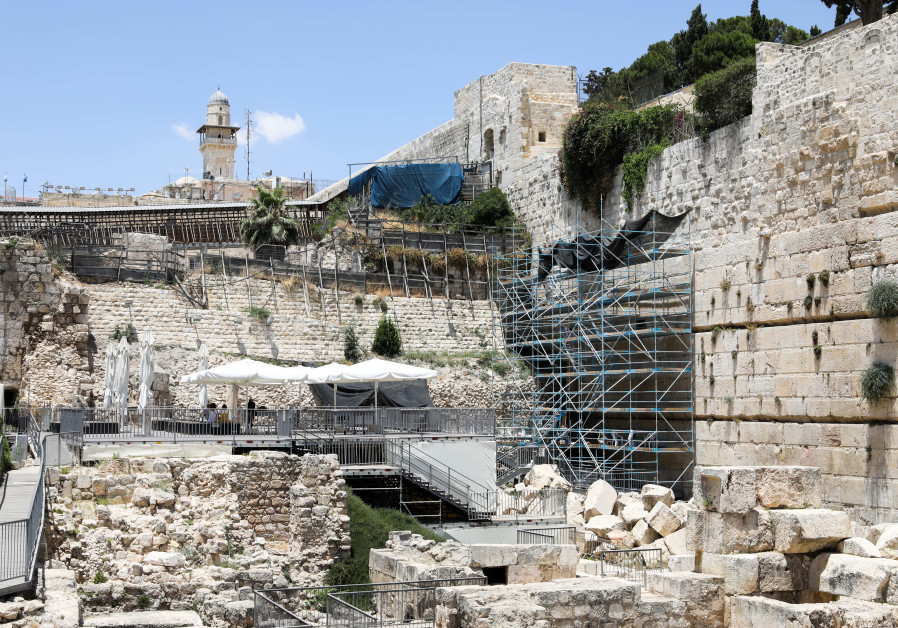‘They are trying to make us feel like second-rate citizens by making us pray at a third-rate place.’

Last July, an ancient stone fell out of the Western Wall onto the egalitarian prayer plaza alongside Robinson’s Arch.
Scaffolding and careful checks of the holy site are still underway, which means that visitors to the pluralistic prayer plaza are unable to pray or access this part of the Kotel since last July.
Members of the pluralistic Jewish community – in Israel and the Diaspora – have shared concern over the conditions, as well as the amount of time it is taking to make Robinson’s Arch “a festive and hospitable place for all denominations.”
“If this had been the other side of the Kotel [Western Wall], the government would have made sure that it would take less than a week to fix – it wouldn’t have been tolerated for a week on the other side,” said Yizhar Hess, executive director and CEO of the Conservative Judaism movement in Israel. “This area is only 25% of the Western Wall, it should not take a year to do.”
Workers at the scene, speaking out of anonymity, told the Jerusalem Post that the repairs are done in a meticulous process, and that they have to check the section of the wall stone by stone, which is why it is taking so long to complete.
However, this doesn’t explain why the area itself seems neglected including the wooden flooring, which is old, worn out and not looked after.
Robinson’s Arch has been a contentious point of debate for years in the Jewish world. On January 31, 2016, a deal was finally brokered following nearly four years of negotiations between the Masorti and Reform movements, the Western Wall Heritage Foundation, Women of the Wall, the Jewish Federations of North America and the Prime Minister’s Office.
However, Prime Minister Benjamin Netanyahu shelved the deal in June 2017 after caving into ultra-Orthodox pressure over the issue, which left Diaspora Jewry, especially in the Reform and Conservative movements, reeling.
Hess said that although the area has been badly maintained, “I’m not bashing the people who are trying their best to look after it with the means that they have.
“But when you look at it, you can’t compare where we pray and what we see here to the other side [of the Western Wall Plaza],” he pointed out. “It’s not only that it’s temporary and not festive, now we have no access to the wall.”
Union for Reform Judaism President Rabbi Rick Jacobs told the Post that “despite the current conditions of the second-rate space brought about by [Israeli] government lethargy and obstructionism… there are active prayer groups participating in meaningful prayers at the egalitarian section of the Kotel, including hundreds of people each Shabbat.”
Hess said that the Conservative Movement in Israel was working hard to make the area “a warm and hospitable place,” but it’s been difficult because for the last year no one has had access to the Wall.
“None of our participants have been able to touch the wall,” he said. “We have a 100,000 participants a year in our prayers there, which is a growing number, and it’s unbelievable that for the last year, they cannot touch the wall.”
He said that after the Kotel deal was shelved, the prime minister said he would do his best to implement the physical aspects of the deal, which to this day has still not been fulfilled.
Asked by the Post for comment on the matter, the Prime Minister’s Office said: “We are not offering comment on that issue at this juncture.”
Women of the Wall Executive Director Yochi Rappeport shared similar sentiments to Jacobs and Hess. “They [the government] are trying to make us feel like second-rate citizens by making us pray at a third-rate place,” she said. “The plaza is not a place where someone can feel at home. I know the reform and conservative movement use it all the time, but they don’t really have a choice.”
She said that these streams of Judaism joined the Women of the Wall movement “because they understand that they are changing it for the better – for everyone, not only for us.”
“We’re bringing a resolution that Judaism has to be more than one way,” Rappeport emphasized.
“This starts at the Western Wall, the symbol of the Jewish nation,” she said.
As reported by The Jerusalem Post
